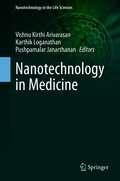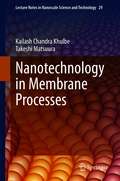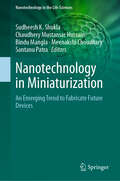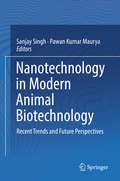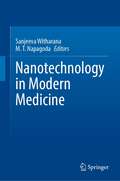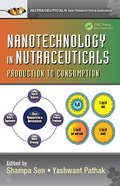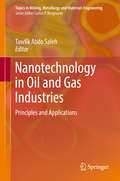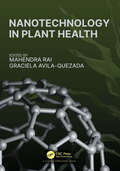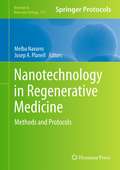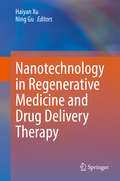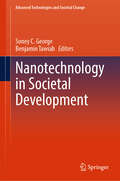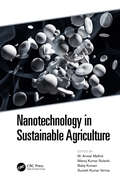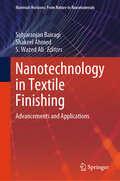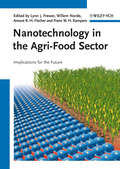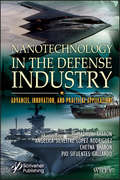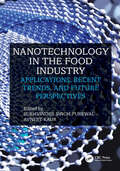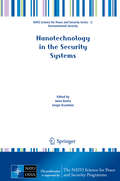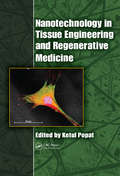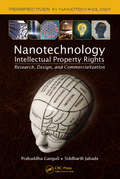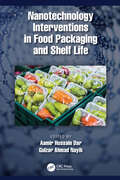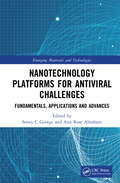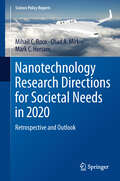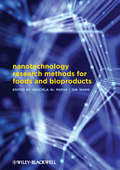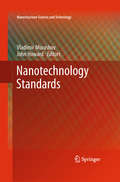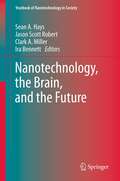- Table View
- List View
Nanotechnology in Medicine (Nanotechnology in the Life Sciences)
by Vishnu Kirthi Arivarasan Karthik Loganathan Pushpamalar JanarthananNanomedicine is the field of science that deals with organic applications of medicine at the nano-scale level. It primarily addresses finding, anticipating, and treating sickness, as well as using nanotechnology to assist in controlling human frameworks at the cellular level. The nature of nanotechnology allows it to address numerous medical issues in humans. This book offers comprehensive information to better comprehend and apply multifunctional nanoparticles in nanomedicine, and thus open avenues in the field.Medicating at the nanolevel is an exceptional therapeutic avenue, as it avoids symptoms associated with conventional medicines. This book investigates recent insights into structuring novel drug delivery frameworks. It concentrates on the physical characteristics of drug delivery transporters, and the preliminary procedures involved in their use. The book offers in-depth detail that benefits academics and researchers alike, containing broad research from experts in the field, and serves as a guide for students and researchers in the field of nanomedicine, drug delivery, and nanotechnology.
Nanotechnology in Membrane Processes (Lecture Notes in Nanoscale Science and Technology #29)
by Kailash Chandra Khulbe Takeshi MatsuuraNanotechnology has been established in membrane technology for decades. In this book, comprehensive coverage is given to nanotechnology applications in synthetic membrane processes, which are used in different fields such as water treatment, separation of gases, the food industry, military use, drug delivery, air filtration, and green chemistry. Nanomaterials such as carbon nanotubes, nanoparticles, and dendrimers are contributing to the development of more efficient and cost-effective water filtration processes. Gas separation and carbon capture can be significantly improved in flue gas applications. Nanoporous membrane systems engineered to mimic natural filtration systems are being actively developed for use in smart implantable drug delivery systems, bio artificial organs, and other novel nano-enabled medical devices. The microscopic structure of nanoporous ceramic membranes, mainly focusing on zeolite materials, as well as the energy-saving effect of membrane separation, contribute to various chemical synthesis processes. In the food industry, nanotechnology has the potential to create new tools for pathogen detection and packaging. For each application, nanotechnology is mostly used to make composite membranes, and the book provides a detailed look at the mechanisms by which the composite membrane works in each application area.
Nanotechnology in Miniaturization: An Emerging Trend to Fabricate Future Devices (Nanotechnology in the Life Sciences)
by Sudheesh K. Shukla Chaudhery Mustansar Hussain Bindu Mangla Meenakshi Choudhary Santanu PatraNanotechnology is rapidly growing as a new technology alternative to create advance materials with unique characteristics and performance for vast applications in a range of industrial sectors. In recent years, a number of nanotechnology-based products have appeared in our day-to-today lives. On the other hand, industries have also considered nano-concepts to produce high-added value products with superior capacity, reliability, and efficiency. The field of nanotechnology is one of the most popular areas for current research and development in almost all technical disciplines. This includes miniaturization of microelectronics, nanomedicine, nano-emulsion particles, fuel cell catalysts, self-assembled polymer films, nanofabrication, imprint lithography, and more. This book summarizes recent advances in miniaturization using nanotechnological approaches. The ability to interact with matter at nanoscale has led to the development of nanoarchitecture and nanomaterials which have the capability of exceeding the limits of conventional modalities. This book provides insight into the development and trends which are progressing quickly in the field of nano-miniaturized-based devices and tools. This book offers an overview of the evolution of miniaturization of engineering systems and devices, which was initiated over one-half century ago. The trend of further miniaturization of devices to the ultimate atomic scale will not only continue, it will become a dominant technological development in the first half of the new century, if not for longer. Such development will require significant changes in every aspect of design and manufacturing, as well as production management over traditional engineering practices. Production of miniaturized device components and engineering systems of micro- and nanoscale is clearly beyond the capability of current machine tools. Manufacturing of nano-scaled devices and components involves isolation, transportation, and re-assembly of atoms and molecules. This nanomachining technology involves not only physical-chemical processes as in the case of microfabrication, but it also involves application and integration of the principles of molecular biology.
Nanotechnology in Modern Animal Biotechnology: Recent Trends and Future Perspectives
by Sanjay Singh Pawan Kumar MauryaThe book introduces the basic concepts of nanotechnology and the various technologies to characterize nanomaterials. It also covers the nanostructural features of mammalian cells/tissues and related nanomechanical properties. In addition, the book comprehensively describes the current state-of-the-art and future perspectives of nanotechnology in biosensors. It also discusses the potential of nanotechnology for delivering the diverse cancer therapeutics and illustrates its limitation due to the potential toxicity associated with oxidative stress. It also highlights the ethical issues and translational aspects related to nanotechnology. Finally, it summarizes the applications of nanotechnology in animal biotechnology, the recent perspectives and future challenges of nanomedicines. The content of the book are beneficial for the undergraduate, postgraduate and doctoral students as well the professionals working in the area of nanotechnology and nanomedicines.
Nanotechnology in Modern Medicine
by Sanjeeva Witharana M. T. NapagodaThis book highlights the applications of nanotechnology in modern medicine. Today we are living in a world of fast-changing behavior and lifestyles. Despite health and wellbeing are often pronounced and enforced, the diseases and illnesses are emerging in different forms, at an alarming rate. Protecting the mankind is becoming ever more challenging. In this backdrop, medicine needs new approaches and technologies to build the defenses. Nanotechnology is successfully confronting the situation. It does so in two avenues, namely, nanomaterials, and, nanodevices. Nanomaterials possess extraordinary properties that are utilized to confront bacteria and viruses, and for targeted drug delivery. Nanodevices can be maneuvered inside the human body to reach extreme locations. This book presents the latest developments in these areas.
Nanotechnology in Nutraceuticals: Production to Consumption (Nutraceuticals #4)
by Shampa Sen Yashwant PathakWhile nutraceuticals were verified to be expedient, they often lack stability, bioavailability, and permeability, and nano-nutraceuticals are being developed to afford a solution to the problem. Nanotechnology in Nutraceuticals: Production to Consumption delves into the promises and prospects of the application of nanotechnology to nutraceuticals, addressing concepts, techniques, and production methods. Nutraceuticals retain less stability, efficacy, and bioavailability when entering the human body. To overcome such problems, nanotechnology shows promise when applied as a tool to improve the quality and stability of nutraceuticals. This book discusses metallic nanoparticles and their applications in the food industry with specific application to nutraceuticals. It includes detailed discussion on potential functional properties of nutraceuticals with regard to antimicrobial activity, anti-inflammatory activity, and anti-cancer activity. Since nanoparticles can be toxic past a certain limit, implementing nanotechnology under thoughtful regulations is considered critical. The book addresses these issues with chapters covering the principles for the oversight of nanotechnologies and nanomaterials in nutraceuticals, the implications of regulatory requirements, the ethics and economics of nano-nutraceuticals, and consumer acceptance of nanotechnology based foods.
Nanotechnology in Oil and Gas Industries
by Tawfik Abdo SalehThis book provides a powerful source to develop new, rapid and highly efficient materials for the application in various fields of oil and gas fields. It focuses on the synthesis, characterization and applications of various Nanomaterials, presenting the state-of-the-art in developments and innovations in nanocomposites. This book provides the complete practical and theoretical information about the synthesis of nanoparticles with potential use in the field of oil and gas.
Nanotechnology in Plant Health
by Mahendra Rai Graciela Avila-QuezadaNanotechnology is an emerging, pivotal platform for enhancing plant health. On one hand, nanomaterials serve as crucial nutrients and nanofertilizers, while on the other, they have demonstrated their potential for diagnosing plant diseases, delivering fungicides and pesticides, and providing therapeutic solutions against diseases caused by pathogens and parasites.The book Nanotechnology in Plant Health explores the significance of nanomaterials in plant nutrition, nanofertilizers, and their role in managing plant pathogens, including the most formidable ones like quarantined strains. This unique publication represents a global team of contributors and stands out for its comprehensive coverage of plant nanonutrients, nanofertilizers, and nano-plant protectors.
Nanotechnology in Regenerative Medicine
by Josep A. Planell Melba NavarroNanotechnology plays a key leading role in developing tools able to identify, measure, and study cellular events at the nanometric level as well as in contributing to the disclosure of unknown biological interactions and mechanisms, which opens the door for advances including nanodevices for diagnostic and therapy, drug delivery systems, and regenerative medicine. In Nanotechnology in Regenerative Medicine: Methods and Protocols, expert researchers in the field provide an overview of a very wide range of currently used technologies and methods that involve nanotechnology principles applicable to tissue regeneration. Being that the application of nanotechnology to regenerative medicine is a very broad field, this book focuses its interests on particular areas such as its use as a means to produce efficient platforms and structures for tissue engineering, delivery systems and biosensors, as well as the use of some techniques to study materials surfaces and the interactions between cells, biomolecules, and surfaces at the nanoscale. Written in the highly successful Methods in Molecular BiologyTM series format, chapters include introductions to their related topics, lists of the necessary materials and reagents, step-by-step, readily reproducible laboratory protocols, and tips on troubleshooting and avoiding known pitfalls. Authoritative and accessible, Nanotechnology in Regenerative Medicine: Methods and Protocols provides established scientists, junior researchers, and students involved in the bioengineering, biotechnology, and biomedical fields with a sound foundation in a variety of vital nanotechnology approaches in regenerative medicine.
Nanotechnology in Regenerative Medicine and Drug Delivery Therapy
by Haiyan Xu Ning GuThe book focuses on the application of nanotechnologies in scaffold-guided tissue regeneration and in drug delivery systems for use in immunotherapy and overcoming drug resistance in cancer treatment. It covers a variety of topics, including nanomaterials for immunomodulation and immnunotherapy; molecular studies on self-assembly for peptides and DNA and related applications in tumor diagnosis and therapeutics and against human pathogenic bacteria; magnetic and conductive scaffolds for guiding tissue regeneration; multiple functions of magnetic nanoparticles in drug delivery and regenerative medicine; and re-purposing of traditional medicine in nano-formulations. In addition, it discusses common effects of nanomaterials, including reactive oxygen species and protein corona. Providing valuable insights and the presenting the latest research advances, the book allows readers to gain a systematic understanding of the topic.
Nanotechnology in Societal Development (Advanced Technologies and Societal Change)
by Soney C. George Benjamin TawiahThis book investigates the complex effects of nanotechnology across numerous fields such as nanomedicine, tailored therapy in medicine and health care, transformational treatment choices for various illnesses, electronics, and computing via miniaturization. In addition, the contributions of nanotechnology to quantum computing, and flexible electronics has been examined. More so, the book discusses the advantages of nanotechnology in the energy and environmental sectors, such as solar cells, energy storage systems, and water purification technologies, in order to solve major global concerns. The impact of nanotechnology on materials and production processes, with applications in construction, aerospace, and other fields, is highlighted. The book further discusses the ethical and societal issues such as safety, privacy, equal access, and thoroughly examined how to strike a balance between innovation and responsible development of nanotechnology in the context of stringent rules and proactive risk assessment. Furthermore, the ability of nanotechnology to bridge the technological divide in underdeveloped nations while minimizing environmental implications is also highlighted.
Nanotechnology in Sustainable Agriculture
by M. Anwar Mallick, Manoj Kumar Solanki, Baby Kumari, and Suresh Kumar VermaNanotechnology in Sustainable Agriculture presents applications of nanobiotechnology for eco-friendly agriculture practices. Implementing sustainable agriculture techniques is a crucial component in meeting projected global food demands while minimising toxic waste in the environment. Nano-technological tools – including nanoparticles, nanocapsules, nanotubes and nanomolecules – offer sustainable options to modernise agriculture systems. Written by nanotechnology experts, this book outlines how nano-formulations can improve yield without reliance on chemecial pesticides and reduce nutrient losses in fertilization. It reveals how nanotools are used for rapid disease diagnostics, in treating plant diseases and enhancing the capacity for plants to absorb nutrients. Features: Combines nanotechnology and agronomy presenting applications for improving plant performance and yields. Reveals nanotechnology-based products used for the soil and plant health management which mitigate climate change. Discusses roles of microbial endophytes, heavy metal nanoparticles and environment health, nano-nutrients, phytochemicals, green bioengineering and plant health. This book appeals to professionals working in the agriculture and food industry, as well as agricultural scientists and researchers in nanotechnology and agronomy.
Nanotechnology in Textile Finishing: Advancements and Applications (Materials Horizons: From Nature to Nanomaterials)
by Satyaranjan Bairagi Shakeel Ahmed S. Wazed AliThis book is focused on the latest developments and practical applications of nanotechnology in textile finishing. It covers the fundamentals of nanotechnology, including the properties and behavior of nanoparticles, and how they can be used to enhance the performance of textiles. The book also explores the various types of nanomaterials that are used in textile finishing, such as nanoparticles, nanocomposites, and nano-coatings, and their properties, advantages, and limitations. The book covers the different types of textile finishing techniques, including dyeing, printing, and coating, and how nanotechnology is used to improve their performance. It also covers the environmental, health, and safety aspects of using nanotechnology in textile finishing, and the challenges and opportunities that lie ahead. The book is targeted at textile scientists, engineers, and researchers working in the textile industry, as well as students and academics in textile science and engineering. It is also useful for those in related fields, such as materials science, chemistry, and chemical engineering.
Nanotechnology in the Agri-Food Sector: Implications for the Future
by Lynn J. FrewerProviding an overview of nanotechnology in the context of agriculture and food science, this monograph covers topics such as nano-applications in teh agri-food sector, as well as the social and ethical implications. Following a review of the basics, the book goes on to take an in-depth look at processing and engineering, encapsulation and delivery, packaging, crop protection and disease. It highlights the technical, regulatory, and safety aspects of nanotechnology in food science and agriculture, while also considering the environmental impact. A valuable and accessible guide for professionals, novices, and students alike.
Nanotechnology in the Defense Industry: Advances, Innovation, and Practical Applications
by Madhuri Sharon Angelica S. Rodriguez Chetna Sharon Pio Sifuentes GallardoThis book will be about various aspects related to applications and use of knowledge of nanotechnology in promoting defense activities. The area in which scientists are focusing includes (i) nano-devices such as sensors, GPS & computers, chemical & biological weapons, nano-fabrics, bulletproof materials, nano-stealth coating, use of nanotechnology in various areas of aerospace. It is intended to cover available methodologies and understanding of technologies for these applications. Not only for destructive but also to improve medical and casualty, safety care for soldiers, and to produce lightweight, strong and multi-functional materials for use in body armour, both for protection and to provide enhanced connectivity will be covered.
Nanotechnology in the Food Industry: Applications, Recent Trends, and Future Perspectives
by Sukhvinder Singh Purewal Avneet KaurUnlock the mysteries of nanotechnology's transformative role in the food industry with Nanotechnology in the Food Industry: Applications, Recent Trends, and Future Perspectives. Embark on a journey through the latest research and developments in nanomaterials synthesis, characterization, and manipulation techniques aimed at aligning with consumer expectations. Discuss the fundamental principles underlying nanotechnology and nanomaterials, illuminating their pivotal significance in shaping the future of food production and consumption, as well as applications of nanotechnology in food industry, from revolutionizing packaging and ensuring food safety to enhancing consumer perception and extending shelf life.Key Features Provides comprehensive information on different aspects of nanotechnology within the food industry Presents a wealth of new facts on utilizing the potential of nanotechnology for food materials Reflects the contemporary landscape of nanotechnology in the food sector With a focus on recent advances and future prospects, this book provides detailed discussions on nanosensors, nanoparticles in food formulations, and strategies for shelf-life enhancement. It is an indispensable resource for students, researchers, and scientists seeking to deepen their understanding of nanotechnology's role in shaping the future of food.
Nanotechnology in the Security Systems
by Janez Bonča Sergei KruchininThe topics discussed at the NATO Advanced Research Workshop "Nanotechnology in the Security Systems" included nanophysics, nanotechnology, nanomaterials, sensors, biosensors security systems, explosive detection. There have been many significant advances in the past two years and some entirely new directions of research are just opening up Recent advances in nano science have demonstrated that fundamentally new physical phenomena are found when systems are reduced in size with dimensions, comparable to the fundamental microscopic length scales of the investigated material. Recent developments in nanotechnology and measurement techniques now allow experimental investigation of transport properties of nano devices. This work will be of interest to researchers working in spintronics, molecular electronics and quantum information processing.
Nanotechnology in Tissue Engineering and Regenerative Medicine
by Ketul PopatAlthough nanotechnology applied to medicine has a potentially huge impact on drug delivery and tissue engineering, significant challenges need to be resolved before clinically viable nanomedicine or nanobiomedicine therapies will be available. Skillfully edited, with contributions from an expert panel of researchers, Referred to as "nanomedicine" or "nanobiomedicine," the application of nanotechnology to medicine can impact diagnosis, monitoring, and treatment of diseases, as well as the control and understanding of biological systems. Bringing together an unparalleled field of experts, this volume explores various aspects of nanotechnology and its applications in biomedical fields. The book uses an application-oriented approach to relate laboratory-based research to the development of technologies that are easily adaptable to an industry environment, focusing chiefly on drug delivery, tissue engineering, and regenerative medicine.
Nanotechnology Intellectual Property Rights: Research, Design, and Commercialization (Perspectives in Nanotechnology #8)
by Prabuddha Ganguli Siddharth Jabade"We need to seamlessly integrate IPR in the standard graduate/post graduate courses in science, technology, commerce, creative arts, etc., without over burdening the students with law"—Dr Prabuddha Ganguli, CEO, VISION-IPRNanotechnology Intellectual Property Rights: Research, Design, and Commercialization offers an overview of the dynamics of development and commercialization in nanotech, where strategic integration of IP, R&D, and commercialization has become imperative. It demystifies issues of intellectual property rights (IPR) associated with research, design, technology transfer, and commercialization of innovations in technology-led areas such as nanotech. Gives all stakeholders vital information to instill confidence by helping them better understand their individual roles in the IPR process Designed for a diverse readership that may not have background knowledge of the legal nuances of IPR, this book clearly articulates techno-legal aspects of nano-related innovations to aid their effective integration into businesses. This resource stands apart by using numerous case studies and pictorial illustrations, addressing aspects ranging from ideation to commercialization of IP-enabled nanotechnology. It illustrates the evolving patent landscape in nanotechnology, explores the international patent classification system, and details patenting procedures in a range of jurisdictions, including search for nanotechnology prior art and creation of search strategies. The authors discuss patent-led nanotechnology businesses, presenting a wide range of case studies that address construction of valuable patent portfolios, growth of start-ups, and consolidation of IP-led nanobusinesses through mergers, acquisitions, joint ventures, strategic investments, etc. They also cover patent litigations in nanotechnologies and the significance of strategically crafting agreements related to IP transactions. In addition, they address compliance with contractual obligations, the importance of well-drafted patent specifications, and sensitive aspects of conducting techno-legal due diligence prior to the development and marketing of products. Also covered are vulnerabilities in challenging/defending the validity of patents and negotiating settlements. Integrating use of the IPRinternalise® model for capacity building in human and infrastructural resources, the authors assess the future of IP landscaping in nanotechnology. Here, they focus on patentability, public perception of risks to health and ecosystems, institutionalized management of intellectual property rights, and the steps that will be necessary to meet these and other such challenges on the way to realizing profits in nanotech.
Nanotechnology Interventions in Food Packaging and Shelf Life
by Aamir Hussain DarNanotechnology has revolutionized agriculture and food technology, improving the shelf life of foods through interventions of nanomaterials in the packaging. Smart materials, biosensors, nanobiosenors, packaging materials, nanocarbon dots, and nanodevices address aspects of the food industry, such as food safety, food security, and packaging and shelf life.Nanotechnology Interventions in Food Packaging and Shelf Life shows how nanotechnology has the potential to transform food packaging materials in the future.Nanotechnology applied to food packaging can increase the shelf life of foods, minimize spoilage, ensure food safety, and repair damaged packaging. Key Features Sheds light on benefits of nanotechnology in the food packaging industry Contains information on utilization of nanocellulose and nanofibrils in food packaging Provides an overview of nanosensor applications for shelf-life extension of different food materials This book presents a comprehensive review of new innovations in nanotechnology, packaging, preservation, and processing of food and food products. It serves as a useful tool for food engineers and technologists in the food packaging industry.
Nanotechnology Platforms for Antiviral Challenges: Fundamentals, Applications and Advances (Emerging Materials and Technologies)
by Soney C George and Ann Rose AbrahamNanotechnology provides an innovative platform for drug delivery and antiviral actions. This book discusses the utilization of nano-based formulations for the control of viral agents. The antiviral potential of green synthesized silver, chitosan nanoparticles encapsulating curcumin, photoinduced antiviral carbon nanohorns, and the role of carbon-based materials like fullerenes, and carbon nanotubes in the repression of viral antigens are explained. The book also covers nanomaterial-based solutions for SARS-CoV-2 and other viral infections. Features: Explains theory and practical applications of nanomaterials as antiviral agents. Reviews upscaling of nanomaterials from laboratory to fabrication stage. Illustrates nanocurcumin, silver nanoparticles, and carbon nanoparticles for biomedical applications. Highlights role of nanotechnology in effectively combating viral infections and pandemics. Includes case studies of specific pharma companies. This book is aimed at researchers, graduate students in materials science, microbiology and virology, and pharmaceutical sciences.
Nanotechnology Research Directions for Societal Needs in 2020
by Chad A. Mirkin Mark C. Hersam Mihail C. RocoThis volume presents a comprehensive perspective on the global scientific, technological, and societal impact of nanotechnology since 2000, and explores the opportunities and research directions in the next decade to 2020. The vision for the future of nanotechnology presented here draws on scientific insights from U.S. experts in the field, examinations of lessons learned, and international perspectives shared by participants from 35 countries in a series of high-level workshops organized by Mike Roco of the National Science Foundation (NSF), along with a team of American co-hosts that includes Chad Mirkin, Mark Hersam, Evelyn Hu, and several other eminent U.S. scientists. The study performed in support of the U.S. National Nanotechnology Initiative (NNI) aims to redefine the R&D goals for nanoscale science and engineering integration and to establish nanotechnology as a general-purpose technology in the next decade. It intends to provide decision makers in academia, industry, and government with a nanotechnology community perspective of productive and responsible paths forward for nanotechnology R&D.
Nanotechnology Research Methods for Foods and Bioproducts
by Graciela W. Padua Qin WangFood nanotechnology is an expanding field. This expansion is based on the advent of new technologies for nanostructure characterization, visualization, and construction. Nanotechnology Research Methods for Food and Bioproducts introduces the reader to a selection of the most widely used techniques in food and bioproducts nanotechnology. This book focuses on state-of-the-art equipment and contains a description of the essential tool kit of a nanotechnologist. Targeted at researchers and product development teams, this book serves as a quick reference and a guide in the selection of nanotechnology experimental research tools.
Nanotechnology Standards
by Vladimir Murashov John HowardWritten by a team of experts, Nanotechnology Standards provides the first comprehensive, state-of-the-art reviews of nanotechnology standards development, both in the field of standards development and in specific areas of nanotechnology. It also describes global standards-developing processes for nanotechnology, which can be extended to other emerging technologies. For topics related to nanotechnology, the reviews summarize active areas of standards development, supporting knowledge and future directions in easy-to-understand language aimed at a broad technical audience. This unique book is also an excellent resource for up-to-date information on the growing base of knowledge supporting the introduction of nanotechnology standards and applications into the market.
Nanotechnology, the Brain, and the Future
by Jason Scott Robert Sean A. Hays Clark A. Miller Ira BennettOur brain is the source of everything that makes us human: language, creativity, rationality, emotion, communication, culture, politics. The neurosciences have given us, in recent decades, fundamental new insights into how the brain works and what that means for how we see ourselves as individuals and as communities. Now - with the help of new advances in nanotechnology - brain science proposes to go further: to study its molecular foundations, to repair brain functions, to create mind-machine interfaces, and to enhance human mental capacities in radical ways. This book explores the convergence of these two revolutionary scientific fields and the implications of this convergence for the future of human societies. In the process, the book offers a significant new approach to technology assessment, one which operates in real-time, alongside the innovation process, to inform the ways in which new fields of science and technology emerge in, get shaped by, and help shape human societies.
